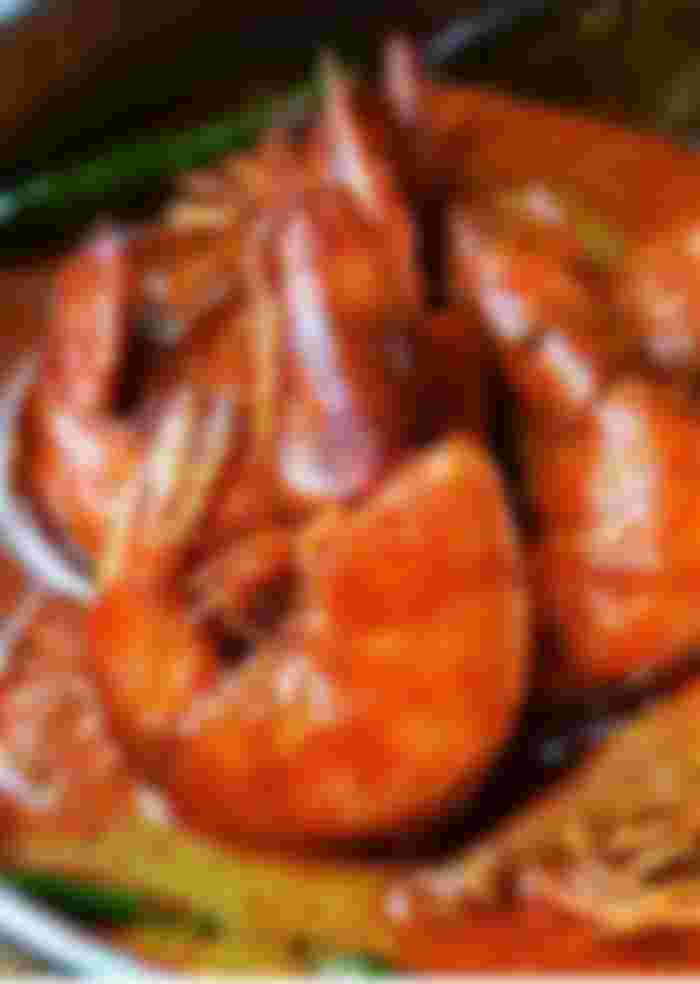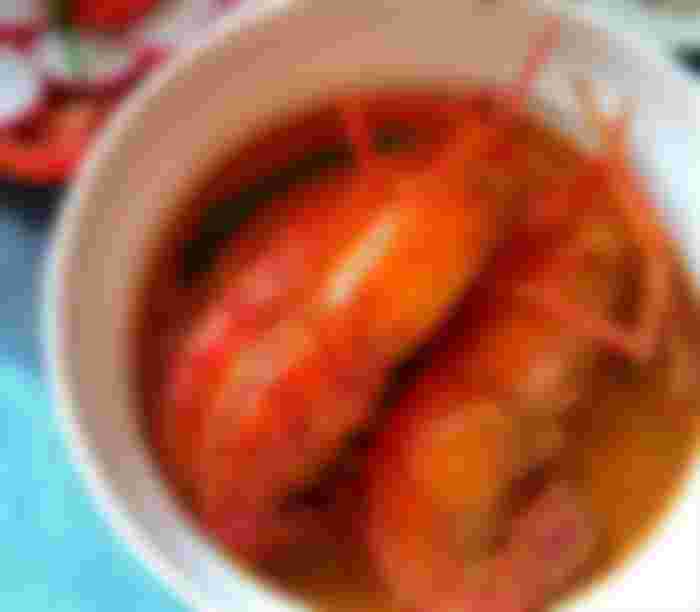
Chingri malai curry (Bengali: চিংড়ি মালাই কারি) also known as prawn malai curry, is a Bengali curry made from prawns and coconut milk and flavoured with spices.[1] The dish is popular throughout Bengal[2][3] and is served during weddings and celebrations, or for guests,[4][page needed] and was also very popular among the British in Calcutta.[5][page needed]
Chingri malai curry
Grøntsager og tigerrejer i rød karry (4477230448).jpg
Alternative names
Prawn malai curry
Type
Curry
Course
Main course
Place of origin
Bengal
Region or state
Bengal
Associated national cuisine
India, Bangladesh
Serving temperature
Hot
Main ingredients
Prawns and coconut milk
Variations
Lobster malai curry
Cookbook: Chingri malai curry
Ingredients
The main ingredients are prawns and coconut milk, along with ghee or mustard oil, onions, turmeric powder, chopped green chilli, garlic paste, and ginger paste flavoured with spices.[6] To give the curry a bright red or maroon colour, 2 teaspoon of sugar can be added in mustard oil in which the curry has to be prepared.
Lobster malai curry is a variation of this dish.[7]
The hard shells of the prawns are removed and marinated with sesame seeds and posto seeds (which are made into a paste). The prawns are then fried in hot oil along with onion, ginger, garlic, and stirred with turmeric and sugar and salt and coconut milk for a few minutes

I am Bangladeshi. I am a Bengali girl. I love to cook and eat. I prefer my mother’s hand cooking to outside food. I used to cook on my own but I still like my mother's cooking. I cooked shrimp cream today. This shrimp malaikari is a very famous dish not only in Bangladesh but also in other countries. It is a favorite food of most people. Moreover, Bengali is Bengali in fish and rice. Everyone likes fish. However, shrimp malaikari is one of them. Desividasabai likes.
For those of you who are not familiar with the history, Bangladesh and the current state of West Bengal, together, used to be one state in pre-independent India–Bengal. The state was split into West Bengal and East Pakistan (now Bangladesh) in 1947 based on religious differences, leading to the largest forced migration of people in history. The Hindus from Bangladesh came over to West Bengal and the Muslims from West Bengal migrated to East Pakistan/East Bengal. While symbolically constructed notions of differences based on food, language, culture etc. had existed between East Bengal and West Bengal even before the divide, the partition gave rise to two distinct and enduring categories of Bengalis–Bangals (East Bengali migrants) and Ghotis (natives of West Bengal).
With time and with gradual increase in the settled status of East Bengali Hindus in Kolkata, the attitudinal differences between Bangals and Ghotis in regard to regional-cultural distinctiveness reduced. However, the battle between two mildly distinct culinary cultures continues with almost as much, if not equal, might even today. So Bengali addas are frequently (actually always) laced with debates about Bangal/Ghoti ascendancy in the culinary world. Seemingly antagonistic sentences like “it’s hard to distinguish a ghoti dessert from a ghoti lentil soup”, or “bangals would put fish heads in their rice puddings if they could”, or “ghotis don’t know how to cook” (I am a ghoti, btw) are uttered more frequently than pleasantries in West Bengal. Who wins these arguments? Usually whoever can shout the most (and they say shouting is a bangal talent 😉 ). But, really, if you ask me, I think McDonalds and KFC are winning due to this fight between Bangals and Ghotis.
Such Bangal-Ghoti battles are waged in the De-Mukherjee household on a regular basis. You see, Mr. De is a Bangal. However, his natural proclivity to criticize every thing Ghoti has declined over the years. So much so that in Bangal-Ghoti culinary debates these days, he finds himself awkwardly occupying the middle, standing close to me, stroking my back, objecting all Bangal attacks on Ghoti cooking with a mellow “but there are exceptions of course”, which is equal to losing as far as Ghotis are concerned. But he makes up for his losses in the culinary debates with twice as much aggression in soccer. All East Bengal and Mohun Bagan (West Bengali soccer club team) soccer debates in this household are won by Mr. De, but this one is due to no fault of mine. Mohun Bagan isn’t helping me very much in this regard.
But the Ghoti-Bangal debate culminates in the fight between prawn and hilsa fish for the crown position in Bengali cuisine. For Mr. De, hilsa wins unequivocally. But I think prawn is more versatile and transnational. It is impossible to get fresh hilsa in the US anyway. So this is another fight that the Ghoti is winning here. 🙂
Now, Prawn malaikari has many versions. Every family does it differently. The recipe I am sharing today is my eldest paternal aunt’s. She is the ghotiest of all Ghtois, and indeed guilty of adding one whole tablespoon of sugar to the sauce, and that is exactly what makes this dish so wonderful. The punch from the mustard oil and mustard powder balances the sweetness perfectly.
Chingri-macher-malaikari
PRAWN MALAIKARI RECIPE
Level: easy Preparation time: 15 mins Cooking time: Serves: 4-5
Ingredients:
1 lb large prawns (about 30 pieces)
1/4 tsp turmeric
1 pinch of salt
2 tbsp mustard oil
4 cardamoms
1 inch cinnamon stick
1 bay leaf
1/2 tsp (or less) cumin seeds
1 tsp ginger paste
1 cup very finely chopped onions
2 green chilies, chopped
1/2 tsp turmeric powder
1 can coconut milk
salt to taste
1 tsp sugar (if you are a Ghoti, then go for it)
2 tsp mustard powder
1 tbsp ghee
malaikari-recipe
Instructions:
Add turmeric and salt to the prawns and mix well. Let sit for 5 minutes.
Heat mustard oil in a pan, add the prawns and saulte for 2-3 minutes. Remove from oil with a slotted spoon and drain on a paper towel lined plate.
To the same oil, add cardamoms, cinnamon, bay leaf, cumin seeds, and ginger paste (add some extra oil if necessary).
As soon as they start spluttering, add onions. Saute the onions over medium to low heat until soft and golden.
Add the chopped green chilies, mustard powder, and turmeric. Add a little bit of water and cook for 4-5 minutes, or until the onions completely melt.
Add coconut milk and bring to a boil.
Add salt and sugar. Give it a taste to check for seasonings.
Reduce the heat to a simmer and cook until oil separates, about 5-6 minutes.
Add the fried prawns, bring the pot to a boil, and finish with ghee.
Serve with steamed white rice.

